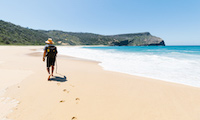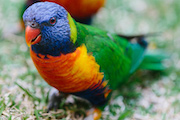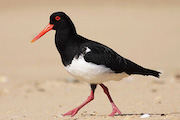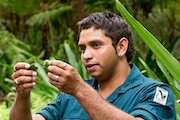Stories
Listen to some of our podcasts to hear more about Booderee. Bernie McLeod, a Traditional Owner of the Country, and Ranger Martin will guide you through different areas of the park, and share information about the land, nature, history and Culture which is tied to Booderee.
Download resources
- Introduction to the Wreck Bay community (MP3, 1 MB)
- Booderee Botanic Gardens (MP3, 2 MB)
- Telegraph Creek nature trail (MP3, 2 MB)
- Cape St George lighthouse (MP3, 6 MB)
- Cave Beach and surfing (MP3, 4 MB)
- Fishing at Booderee National Park (MP3, 2 MB)
- Murrays Beach (MP3, 2 MB)
- Relax at Steamers Beach (MP3, 3 MB)
- Wreck of The Hive (MP3, 5 MB)
- Humpback Whale off Booderee National Park (MP3, 6 MB)
Transcripts
Introduction to the Wreck Bay community
Welcome to Booderee National Park!
My name is Bernie McLeod and I’m a Traditional Owner of this Country. We are Koori people and we’re part of the Wreck Bay Aboriginal community of Jervis Bay.
‘Booderee’ is an Aboriginal word from our language – the Dhurga language.
The word Booderee means ‘bay of plenty’ or ‘plenty of fish’. We are saltwater people here on the south coast but we have a strong connection to the land too.
Our people have been caring for the land and waters of the Jervis Bay area for many generations. Knowledge of important places – and the land, sea, plants, animals, food and natural medicines – are still being passed on to new generations. It’s all here – and we love to share our knowledge and Culture with visitors like you!
A great place to start your stay is at the visitor information centre. This is the building you can see just on your left as you come into the park.
Our friendly staff, mostly from the Wreck Bay community, can help you plan your stay. They can help you find a place to camp if that’s what you want to do as well.
There’s just so much to do here at Booderee!
Booderee Botanic Gardens
Welcome back… Bernie here again.
I’d now like to take you through a place that is very special to me and my family – the Booderee Botanic Gardens.
These gardens are the only Aboriginal owned botanic gardens in Australia. They cover 80 hectares of Booderee and showcase our traditional use of plants as well coastal plants of south eastern Australia.
Three generations of my family, the McLeod family, have worked on these gardens. I’m very proud to be the curator of the gardens today.
The gardens were established in 1951 because the Australian National Botanic Gardens, in Canberra, needed somewhere that didn’t have frost to grow sensitive native plants.Back then this place was called the Jervis Bay Botanic Gardens. My family helped create many of the paths and plantings you see around you today.
Our Country was handed back to us Wreck Bay people in 1995. Today we jointly manage this special place with the Director of National Parks, so everyone can enjoy it.
We have continued to develop areas and facilities so visitors can learn more about plants in this area, and how we use them. In the gardens you’ll see a shelter that we recently opened to teach school children and other visitors about our Culture. We also got a new amphitheatre for Koori dances and music.
There are many different walks for you to take.
Telegraph Creek nature trail
Hi, I’m Martin –
Telegraph Creek Nature Trail is just at the top end of Green Patch. It’s only a short walk but it’s one of my favourites.
I think the special things that you can see there, is that it is very diverse and it gives you access to one of the really unique habitats in Booderee National Park and that’s the heathland . Heath’s actually quite prickly, and you can’t just sort of walk away, walk through it, but on Telegraph Creek there’s a raised boardwalk there and one of the few places that you can really explore the heathland.
Another special thing about it is it’s an entire catchment, so you can start to understand and look at some of the catchment processes that operate in Booderee National Park. And water flows and soil depths are really important to vegetation type so it’s a great place to learn something about the types of habitats that you get how they develop and what are some of the sort of the faunal associations that you’ll see along the way.
When you start you’ll start in heathland and you can see the big deep sand dunes off in the distance with the tall forest that grow on those deeper soil types that’s a really inviting sort of thing you can sort of wonder up through the heath.
As you go through the heath you’ll hear a whole range of bird calls in particular the really striking call of the eastern bristlebird. It’s a bird you don’t often see but you’ll often hear it, very high pitching ringing sound, really quite a striking call.
As you come up to the top end of Telegraph Creek there’s a lovely seating area there right next to the creek. It’s one of my favourite hotspots just to sit and relax, or I might take a book, or whatever, might just take some time out. Often you’ll see some things like yabbies coming out of the water they’ve got a beautiful striking blue colour so that’s a nice place to sit and just take in the environment and listen to the birds and listen to the water running.
The further you go around you come into some woodland with lots of flowering species so that’s very uplifting and again just another unique habitat you get in Booderee. And right back round to the road again, it’s really just a short walk but you feel like you’ve had a whole day in Booderee National Park.
Cape St George lighthouse
Hi, Martin here again…
I want to talk to you about the lighthouse, it’s absolutely fascinating history is something that will really draw you in, if you want some time out and really think about what happened in the past.
Whilst it’s a ruin now, I guess it used to be the real centre of activity in the Jervis Bay area back in the early 1800s. It’s actually a very sad and compelling history and really reflects what happened in many places in Australia as exploration occurred. A real feature of Australia’s early history was its maritime history and most of people’s transport and most goods were transported up and down the east Australian coast by ship. Many of them came to grief, and there were many stories of tragedy and this area in Booderee National Park is no exception.
The lighthouse was built when it was in a really isolated location and as we understand it now in our reading through history, we believe the contractors just sort of found the easiest spot to build the lighthouse rather than the best spot. It’s a fabulous lighthouse, a beautiful design by the famous architect Greenway, so you know, like those lighthouses in Sydney and you can see those, that in the remnants but now the sad sort of blocks lying all around on the ground. The reason of course why it was demolished was it was found to be located in fact the worst possible location. As the ships came up the coast towards perhaps Sydney or other destinations, they were drawn into the coast, couldn’t see the light at all, and by the time they saw it was just too late they were on the rocks.
There was quite a number of shipwrecks there and the history of each of those individual wrecks is up on boards at the lighthouse, so it’s a great place to go up and reflect.
Another thing about the lighthouse was a real history of isolation and hardship that early explorers I guess had to encounter, in this case the lighthouse keepers. A number of families lived up there and you can just imagine the hardship but also the sense of the wild and exploration that children had. One of the sad stories of the lighthouse was the lighthouse keeper’s daughter and a friend who were skylarking with a gun in a hut called McVale’s Hut, which I’ve looked everywhere for but haven’t been able to find, but perhaps you could find it. Unfortunately the gun went off and Harriet was shot in the head and killed instantly, a terrible story of tragedy for that family, and you’ll now find the grave located at Green Patch so perhaps McVale’s Hut is located somewhere nearby.
Cave Beach and surfing
Hi, Martin here again.
If you’re up for a surf, Cave Beach is a really good surf beach, it faces south, and so it’s got all the elements that surf beaches need to have. The car park’s a little isolated but just a short walk down to the beach itself and I guess in any conditions you can select the spot, whether you want to go to Cave Beach itself, and I don’t know about left handers and right handers, but I’m sure you, if you’re going to surf, you’ll know it when you see it. And you can go to Cave Beach itself, or you can take the short walk through to Bherwerre Beach with the other handed surf that comes in there. Either way I think you’re in for some great conditions.
If you want to take a further a walk there’s some really spectacular coastal scenery along there too. Go from Cave Beach and take the walking track through to Bherwerre Beach and it goes past Ryan’s Swamp. It’s particularly rich in waterbirds and a huge number of snakes, I’ve never been to a place with more snakes, so if you’re into that, watch out! A little further along you come to Bherwerre headland, as I say you can either take a dip and surf, or you can walk along that very large beach right down to Sussex Inlet. Along there you’ll see a really wide variety of the seabirds that take advantage of that area, we’d really appreciate if you keep your distance some of them are quite rare and quite special. Towards the Sussex Inlet end for example is the hooded plover, one of Australia’s rarest seabirds. They nest on the ground so if you spot that little critter please be well aware to stay clear during the breeding season.
Fishing at Booderee National Park
Hi, Martin here again.
Another popular activity at Green Patch is fishing, and you should remember of course you are in a national park and there are some restrictions but you are welcome to fish. It’s a very popular activity and just reminding you that you should just have a single fishing line and a single hook and bring your bait with you, don’t remove bait off the rocks there, it’s an area we try to protect the habitat there.
You’re required to have a New South Wales fishing licence and if you’re not sure what you’ve caught please let it go back into the water again. There’s always a ranger around so you can ask them for advice on what sorts of fish you have, and what sort of things you can take home and eat. If you have a boat and you want to explore Jervis Bay, then at Murrays Beach there’s an all-weather boat ramp and that’s an ideal place to start to explore the waters of the bay.
Murrays Beach
Hi, Martin again.
One of my very favourite spots in the park is Murrays Beach. It looks out over Bowen Island where that large penguin colony is, and it’s one of the few places if you go down in the evening, you’ll see penguins coming past through the gap, and hear their little yaps to each other as they head towards Bowen and onto the island where their breeding colony is.
From Murrays Beach there’s a fabulous loop for those who want to walk a little further. And you can go really as far as you want, if you want to take the loop or extend that walk right out further. The loop track is particularly exciting track if you want to take in the spectacular coastal scenery and the large cliffs. What we really would encourage you to do is stick to the track, because those cliffs are extremely dangerous and crumbly, so stick to the tracks, don’t head off for a closer inspection of those cliffs, just take in that superb view.
Relax at Steamers Beach, Booderee National Park
Hi, Martin here,
If you’re up for a really tough walk but some really exciting scenery I would really recommend taking the Steamers Beach walk. From Steamers Beach car park it’s a really nice walk through some tall forest and some spectacular, small, but really exciting areas of rainforest remnants that are between those huge sand dunes that have wandered inland.
You keep on walking you start to see off in the distance the ocean appearing, then a very steep track leading to a set of stairs. I know how steep they are because I installed them originally about 25 years ago. From memory there’s 250 steps, so be prepared for both the walk down and the walk out. But you will be rewarded with what I believe is one of the highest cliffs off the coast of New South Wales and some really spectacular coastal scenery.
It’s a dangerous beach, so I wouldn’t recommend swimming there. In f act it’s been rated as one of the most dangerous beaches in Australia, with really severe tows, large sharks, because of the nearby sea colony, and no chance of rescue, so I’d really encourage you to be very careful. It’s a great place for a fish but you’ve got quite a walk out with any fish that you do catch.
Wreck of The Hive, Booderee National Park
Hi, Martin here,
So a little bit more about shipping up and down the coast of New South Wales, there was nearly 200 shipwrecks in fact from the period 1875 to 1885. A fascinating story for Booderee is one of those shipwrecks and that’s the Hive.
The Hive was wrecked on Bherwerre Beach, that really long beautiful beach in 1835. Whilst you won’t see any remains, I think it’s really worth a walk along that beach and contemplating what things were like then. That particular ship sank in December around Christmastime with Irish convicts and many women and children on board. It also had a large cargo of gold bullion which I understand was taken off the ship so it’s not worth going looking for it!
Our Koori community were in fact involved in the rescue, and whilst it was a few generations ago, there’s still little bits of that shipwreck around held by families, so a clear link with the past there. There were almost 300 passengers I understand but only one was lost. Later a ship was sent out to retrieve some of the bits and pieces from that ship including the bullion and that was called the Blackbird. Unfortunately it too came to grief there, and it really is a highlight to just how dangerous the conditions can be of those long south facing beaches that are exposed to all the winds and the onshore conditions.
Quite recently the remains were rediscovered using some fairly high-tech equipment, some sonar equipment and so forth, and the site has been mapped really for the purposes of heritage rather than for people to go and see, there really isn’t much to see there, most of it is under the sand.
But again it is worth a walk along there and contemplate the fate of the convicts and what might be their stories now. And it’s also a really awe inspiring beach just to wander and catch some of the seabirds that nest around there.
Humpback Whale off Booderee National Park
Hi, Martin here again.
One of the great reasons for coming to Booderee is to have a look at whales. There are some whales at Booderee all year round. You’ll see dolphins of course all year round, and they are resident in the bay. But some of the visitors include visitors like pilot whales in quite large pods, very exciting to see, or even larger whales like killer whales. Of course the seasonal migration is a legendary and inspiring event to see of the humpbacks and southern right whales.
We most often see humpbacks in Booderee, and we see them on their northern migration, the pregnant females heading north, around June-July.
Around September right through to November, December, the females are heading back and often with their calves. Southern right whales breed further south and in fact can breed in Jervis Bay itself, and we’ve sometimes seen them from Booderee waters with their very young calves, just lolling around in very shallow water, sometimes just 30 metres from the shore.
The humpbacks are often in slightly deeper water but perform great antics.
The two whale types that we commonly see that are seasonal migrators have quite distinct shapes but also you’ll really notice the difference from the blow. The humpback is a single large blow that heads up and then turns into mist as it drifts off in the wind.
Southern right whales are quite rare, rarely seen, but very exciting to see that v-shaped blow that’s caused by the two blowholes, so again very distinctive and very exciting. If you do see southern right whales, please tell us because we do like to pass that on to authorities.
The southern right whales and the humpbacks were hunted nearly to extinction, particularly the southern right whales, but now there are about 2,000 humpbacks which head down the coast and that number is growing every year. When I was first in Jervis Bay, I’d hardly ever see a whale at all, and I spent a lot of time out on the water studying penguins, now I can’t help but see them and it is such an exciting time, so I’d really encourage you to come, have a look at whales, and take in the Booderee environment at the same time.
Some of the top locations that you can see whales from would be the lighthouse where you’ll see them off in the distance and their purposeful travel north and south and actually inside the bay. So if you’re camping at Green Patch, get up early, head down to the beach and see what you can see. I’ve also noticed that just sleeping at night time you are awoken sometimes by the slapping of tails and fins. It’s a time of year I really look forward to.
Stay in touch
Subscribe to receive important updates about Booderee National Park.







